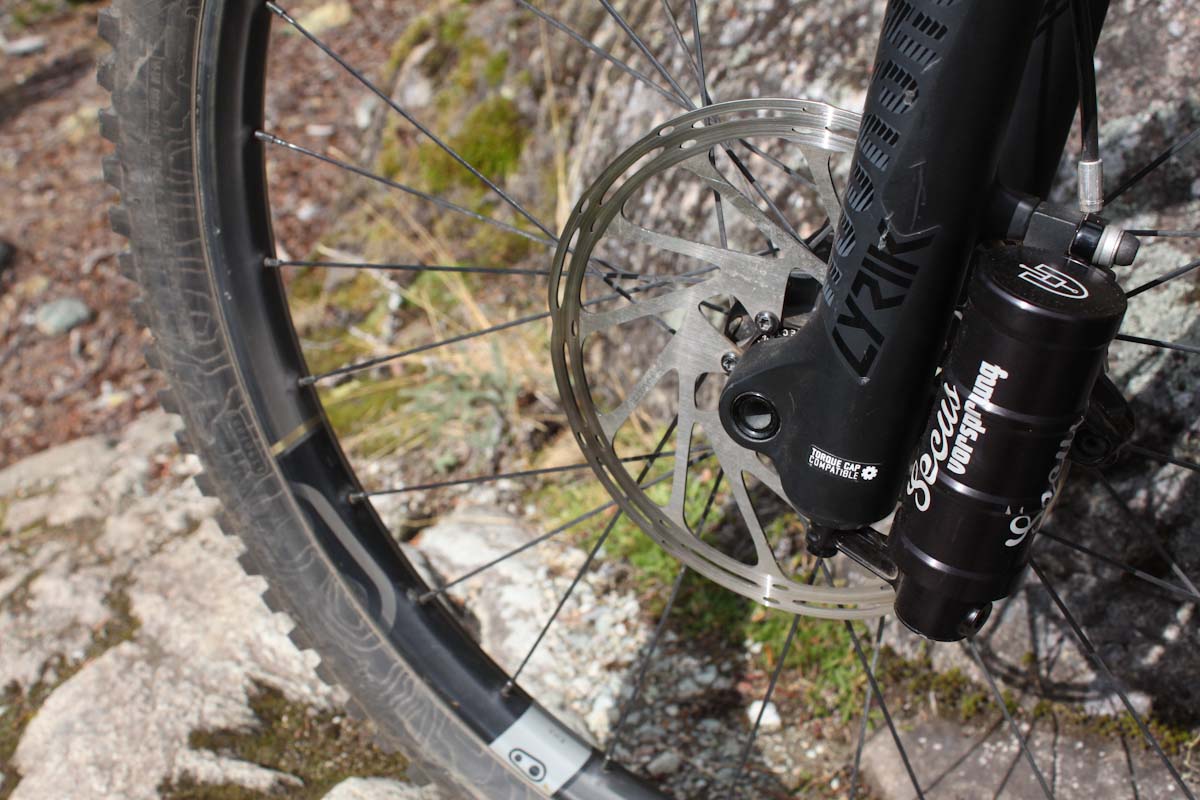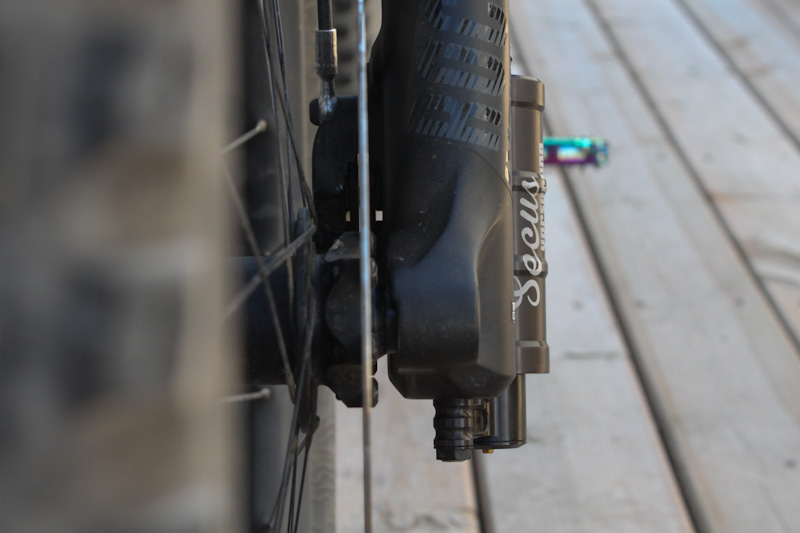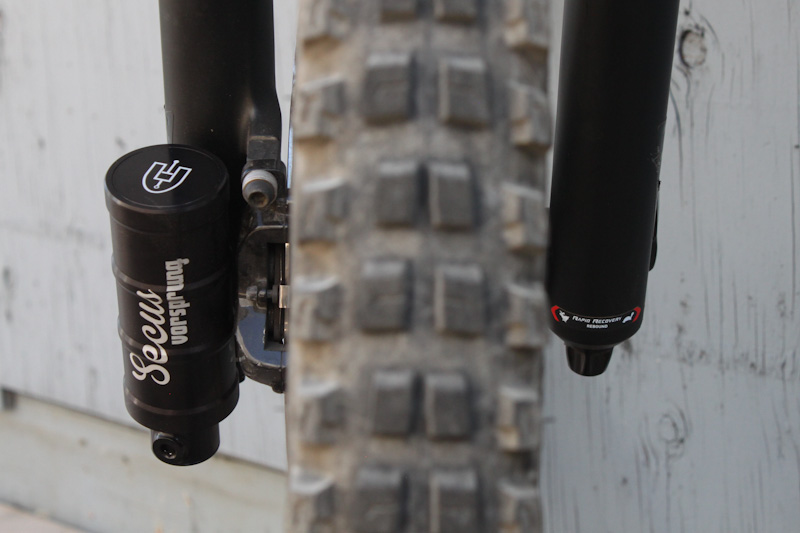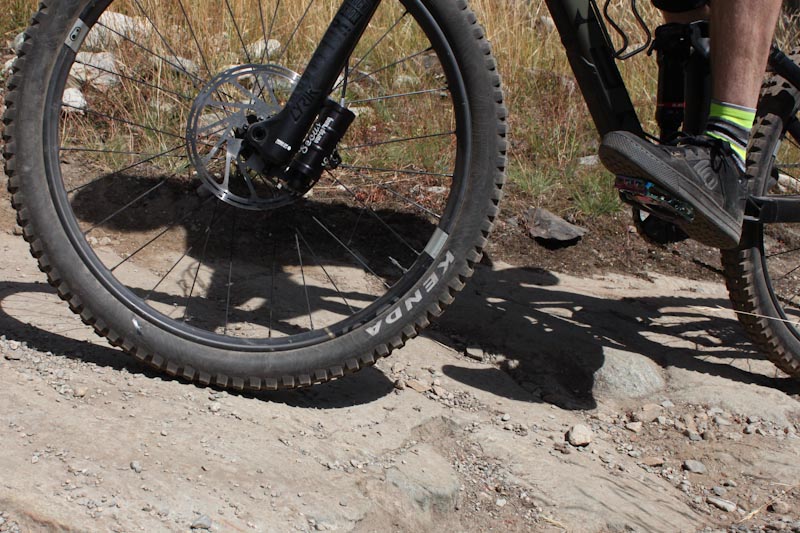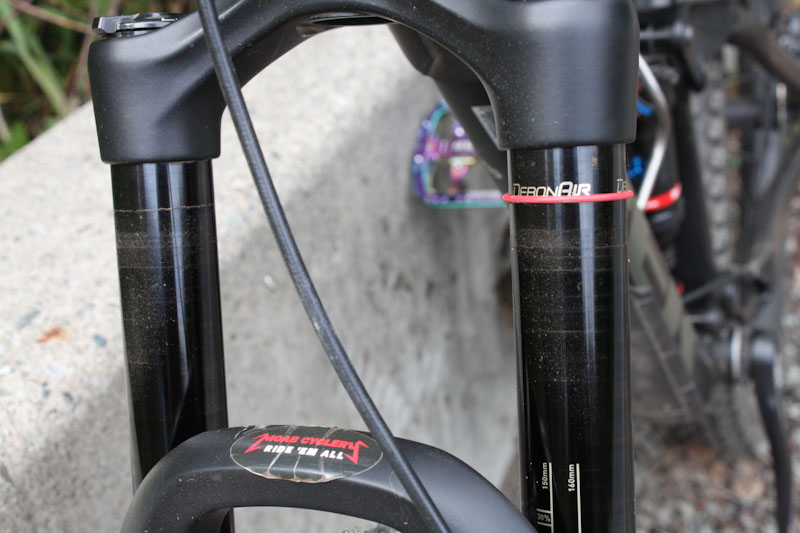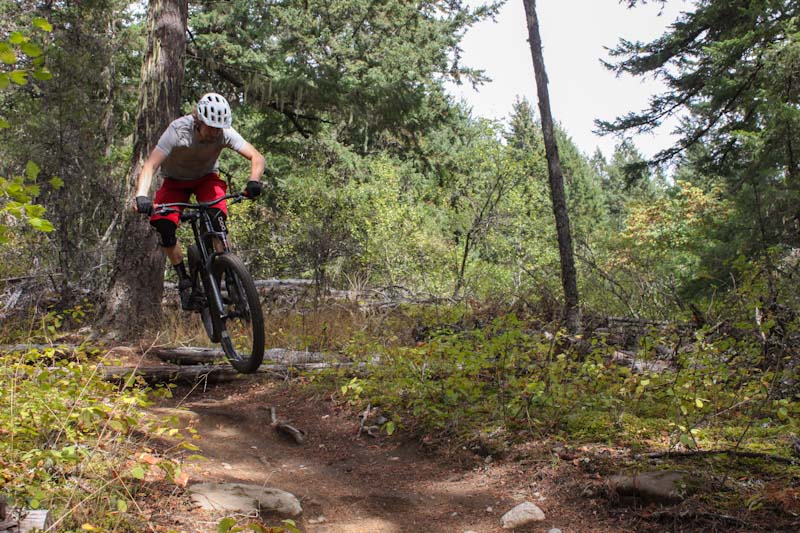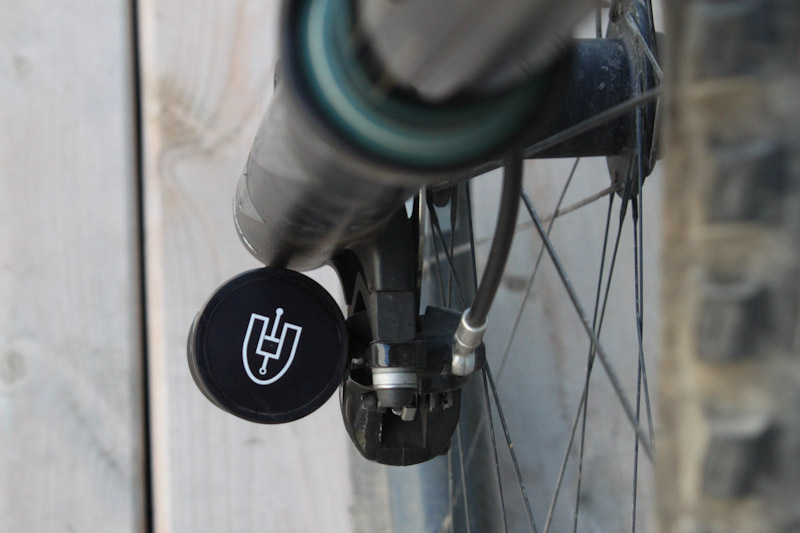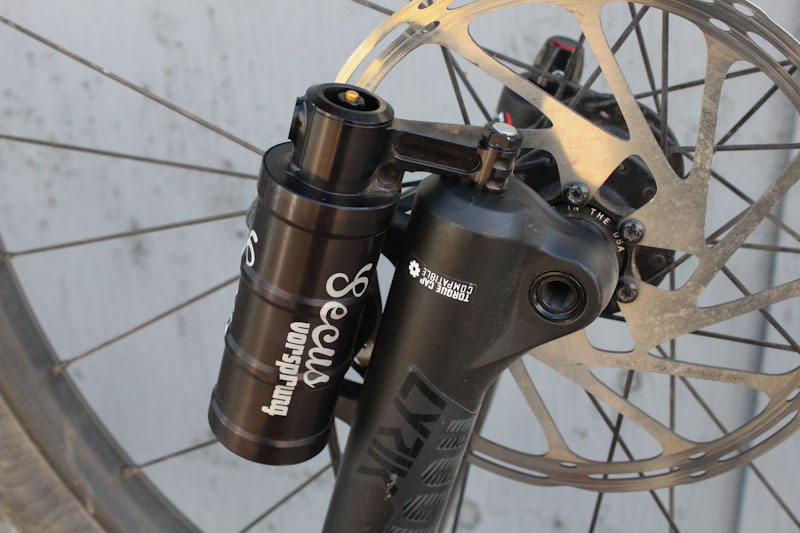It’s easy to dismiss claims in competitive industries like cycling, but when Vorsprung Suspension says their Secus will make your air fork ride better than a coil fork, they’re not kidding. By creating a massive negative chamber, the Secus affords air-sprung forks a whole new level of sensitivity, but it doesn’t just make your fork soft and linear: the Secus also offers good mid-stroke support and bottom-out resistance.
Bikerumor covered the details of the Secus when it was announced, so check out that article for a full explanation of what it does and how. After reading that post I realized my personal bike is running a compatible RockShox Lyrik fork, so I jumped at the chance to put the Secus to the test. And boy am I glad I did!
Vorsprung Secus setup basics:
The Secus attaches to your fork’s footstud, and aligns with the fork leg leaving just enough clearance for your brake caliper. While it catches the eye at first, the Secus actually tucks away quite nicely. Looking from the front, it barely sticks out beyond the fork leg so there’s little chance of smashing it on passing rocks.
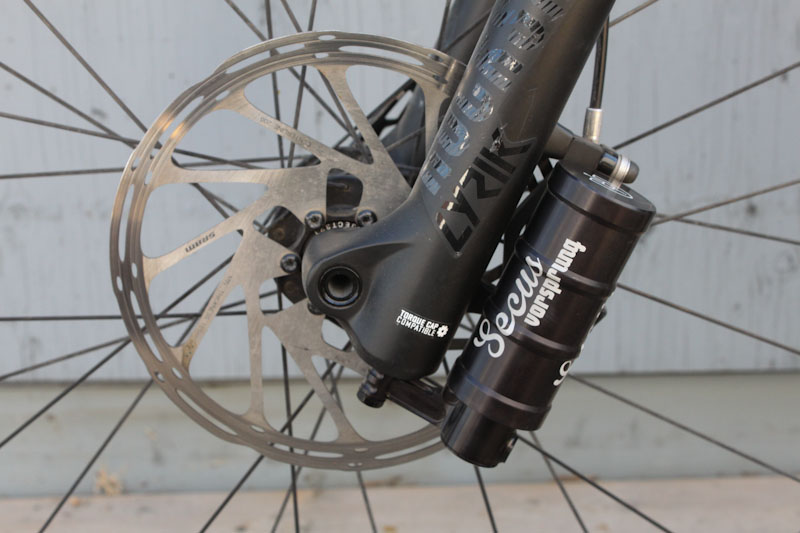 Vorsprung offered to set up the Secus for me, and they nailed it. I only weigh 145lbs and I’m not super hard on bikes so my fork runs with no volume spacers, the low speed compression wide open and the rebound about ¾ to the fast side. Upon installing the Secus, Vorsprung increased my air pressure by 20%. Adding the Secus to any fork will result in a bit more sag, so mine now sits at about 27%.
Vorsprung offered to set up the Secus for me, and they nailed it. I only weigh 145lbs and I’m not super hard on bikes so my fork runs with no volume spacers, the low speed compression wide open and the rebound about ¾ to the fast side. Upon installing the Secus, Vorsprung increased my air pressure by 20%. Adding the Secus to any fork will result in a bit more sag, so mine now sits at about 27%.
On my first ride the setup seemed A-OK: My fork was initially softer and much more sensitive than ever before, it climbed a bit higher than usual in its travel but still sucked up bumps nicely, and I fully bottomed-out during a rough descent.
Ride Impressions:
Vorsprung claims the Secus can make an air sprung fork ride better than a coil fork, offering plush off-the top action, a supportive mid-stroke and superior bottom out resistance. As soon as I hopped on my bike, I had a ‘wow’ moment as my Lyrik felt drastically different than before. It felt way more like a coil fork than I ever thought possible. Its initial and mid stroke were far more sensitive now, and I was truly excited to get out and pound it down some trails.
Climbing:
I’ll go so far as to say the Secus’ supple off-the-top action made an improvement to front wheel traction on the climbs. About the first 30% of my fork’s travel is now super sensitive, and bobbling up the trail I noticed a little less bounce when the front wheel hit an uphill bump. Even when your body weight is shifting rearwards on steep sections, the Secus-equipped fork’s soft initial stroke encourages your front tire to stay glued to roots and rocks.
I find most forks don’t do a great job of dulling really small bumps or vibrations (eg. well packed trails or chunky gravel roads), but with the Secus installed my Lyrik got a bit better at it. It quickly reminded me of the only other fork I’ve ridden that did this far better than most – The Trust Shout.
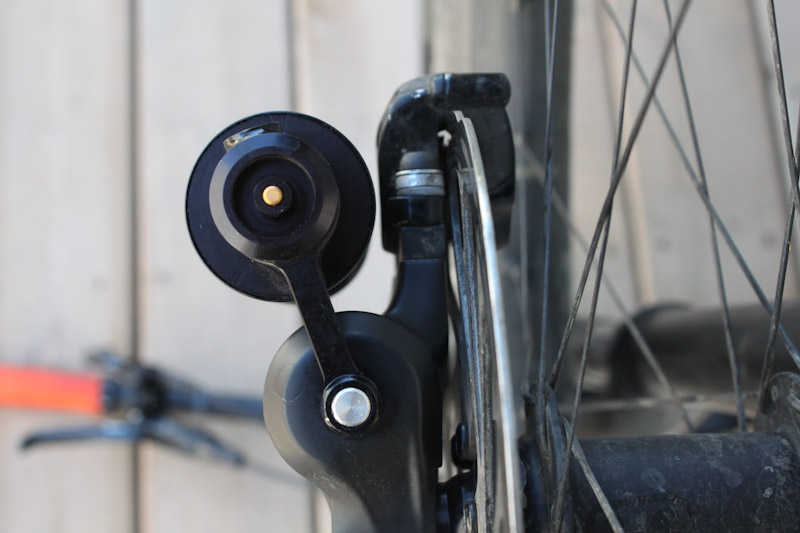
While the initial stroke becomes quite soft with the Secus in action, it does not cause your fork to wallow in its travel while you climb. As soon as you hit the mid-stroke range, the Secus’ Mid-Stroke Support Valve ramps up the support enough to keep you from sinking too deep as you pedal away. When a sharper impact comes along, the fork will give in easily and suck it up very smoothly.
With the Secus, I hit anywhere from 40-55% travel climbing bumpy singletrack. Previously my fork would dive a bit further on the same climbs, so I’d say Vorsprung’s claim of good mid-stroke support was confirmed.
Descending:
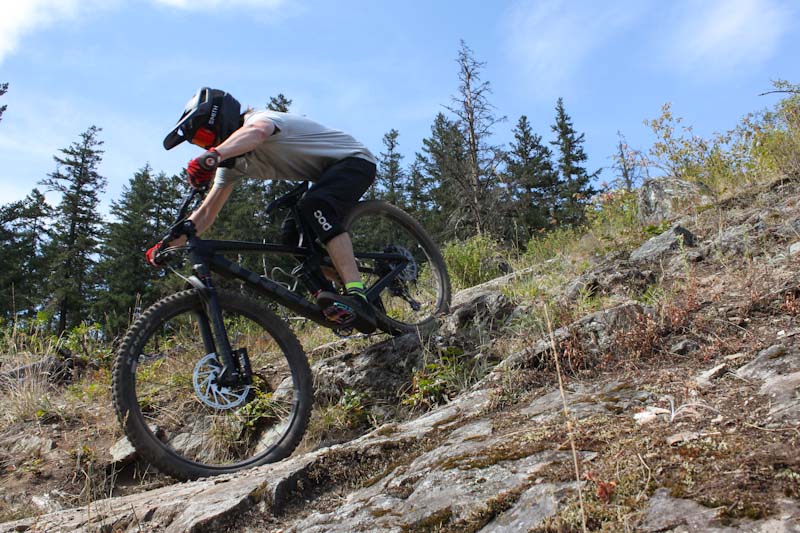 On my first rough, technical descent, I was pleased to find that coil-like softness shines through on nearly any size of bumps. Smaller and medium hits are glossed over with that dull, plush feel that normally only coils can provide. It only gets better as you go faster and ride harder through bigger, sharper hits.
On my first rough, technical descent, I was pleased to find that coil-like softness shines through on nearly any size of bumps. Smaller and medium hits are glossed over with that dull, plush feel that normally only coils can provide. It only gets better as you go faster and ride harder through bigger, sharper hits.
The Secus’ impressive sensitivity takes the initial harshness off high-speed impacts so nicely it got me hyped up to ride harder and faster! Plowing through medium-sized bumps at high speeds, I found the repeated impacts easier on my arms and felt like my front wheel was finding traction in those rough patches better than before.
The Secus does help the fork resist bottoming out to a good extent – I did get all my travel during rougher rides, but on more casual loops I would often wind up a few mm’s away from bottom-out. Prior to running the Secus that’s exactly how my fork rode, so things didn’t change much for me in terms of travel usage. I haven’t spent much time riding coil forks recently so I can’t say if the Secus/Lyrik is better at bottom-out resistance but it definitely ramps up as you approach end-stroke, even with zero spacers in the fork. And don’t forget, the bottom-out resistance can easily be tuned with stock or aftermarket volume spacers.
Despite its sensitivity and softness under impact, the Secus’ ample mid-stroke support still allows my fork to pop nicely off bumps and jumps. I also noticed slower impacts like jump or drop landings feel smoother with the Secus as you dip into that supportive-yet-supple mid-stroke.
I should note, after many rides with the Secus I have not felt the need to alter my rebound or low speed compression settings. I’d never discourage anyone from experimenting with their settings, but rest assured you won’t have to reconfigure your fork to accommodate the Secus and make it perform properly.
At 130g I did not notice the additional weight of the Secus at all, and found it makes no difference to bike handling or steering. It’s not visually distracting either; from a seated position it hides below my handlebar so it’s easy to forget it’s there.
You’ll probably instinctively be a little extra careful putting your bike down with the Secus on, but it really doesn’t stick out much. Laying your bike on a level surface is no problem, and on one ride I rested my bike on a big round rock and it still didn’t contact anything. I did put one scratch on the Secus, but not while riding – There’s an awkward rock passage at the entrance to my trail network, and I knocked the Secus on one of the rocks. It left two little scratches in the body but did no further damage.
The Secus made an undeniable difference to my fork’s ride qualities, and largely lives up to Vorsprung’s claims. For the price of $425 CAD (approx. $320 USD) it’s probably going to cost you less than selling and upgrading an entire fork, and even after riding the brand new RockShox Zeb, I’d still say you’ll get better sensitivity and coil-like bump absorption from the Secus.
